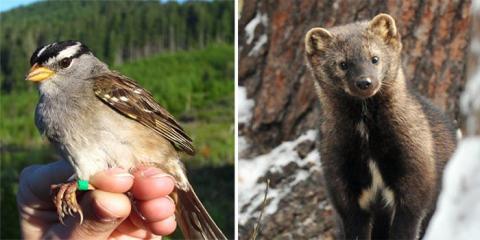Get to know Oregon’s forest wildlife from the safety of your home
May 18, 2020
We know you’re all feeling isolated right now. So are we. It’s true that as a wildlife biologist I spend a lot of time by myself in the woods. I actually love being alone – when it’s by choice. Now that we’re supposed to self-isolate, I want nothing more than to lead wildlife tours and bring folks into the woods with me! I hope we can all be together in the woods again soon. Until then, I thought you might have some extra time to read. The following is a reminder about some of the educational resources the Oregon Forest Resources Institute (OFRI) has available for you to learn about forest wildlife right now, from the comfort of your home.
Our Wildlife in Managed Forests series of publications is updated frequently with relevant information that stems from research conducted by our partners at the National Council for Air and Stream Improvement (NCASI), Oregon State University, (OSU) and the U.S. Forest Service Pacific Northwest Research Station (PNW), to name a few.
Have you ever wondered about forest carnivores? We encourage you to take a look at our Fisher and Humboldt Marten publication. It will teach you a bit about the biology of these fascinating forest carnivores, and it highlights current research aimed at learning more about these creatures’ habitat needs, along with management recommendations for forest landowners.
Beyond having plenty of time to read about forest wildlife, another activity many can still do is bird-watch from their kitchen windows. We have two resources that will teach you more about forest-dwelling songbirds. First is our Early Seral-Associated Songbirds publication, and second is our Guide to Priority Plant and Animal Species in Oregon Forests booklet. The Early Seral-Associated Songbirds publication discusses habitat requirements for songbirds that rely on young forests, also known as early seral habitats, which are often created as the result of wildfires or logging. This publication has a lot of great pictures, and some of the species are commonly found in urban environments too, such as the white-crowned sparrow or the spotted towhee. The Guide to Priority Plant and Animal Species also has many great pictures, and can be used to learn about forest-dwelling wildlife.
If you’re a forest landowner, it’s also a great time to think about plans for your forest. Our Oregon Forests as Habitat publication has recommendations for every age of forest that can be incorporated into your forest management plan. Beyond the recommendations in Oregon Forests as Habitat, you can find many more resources for forest landowners on OFRI’s KnowYourForest.org website. Additionally, we partner with the Woodland Fish and Wildlife Project, a cooperative effort between state agencies, federal agencies and universities to provide information on fish and wildlife management to private woodland owners and managers, to write short publications on a variety of wildlife topics. If you’re interested in wildlife-friendly forest-fire fuels reduction, cavity-nesting birds and many topics in between, we suggest checking out their website.
We hope to see you all out in the forest as soon as we get through this.
Fran Cafferata Coe,
Cafferata Consulting
OFRI Contract Certified Wildlife Biologist®
